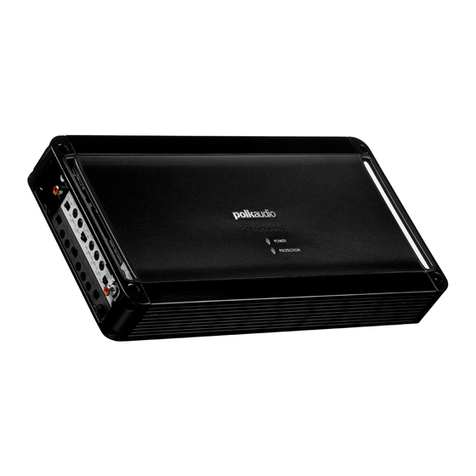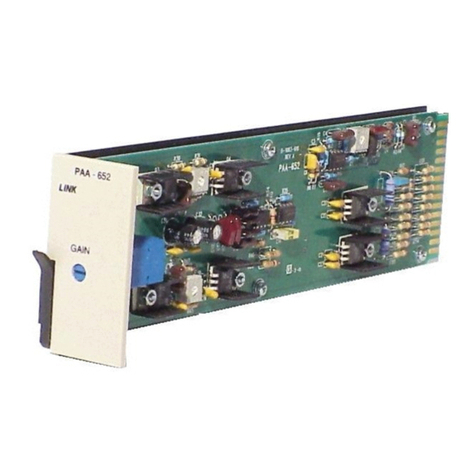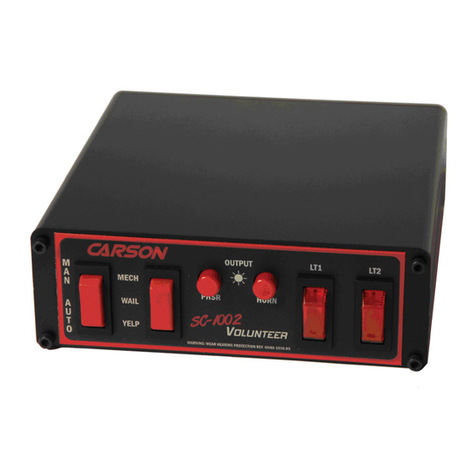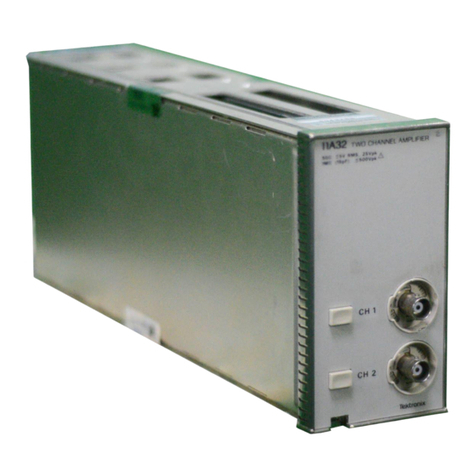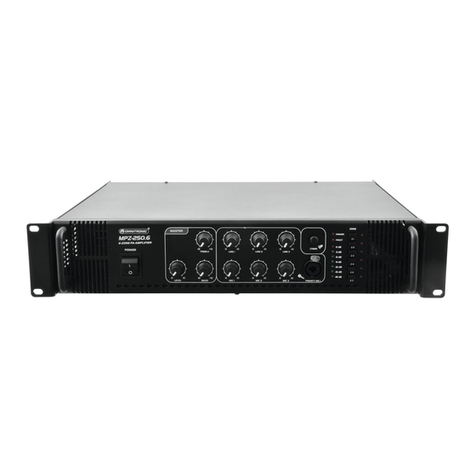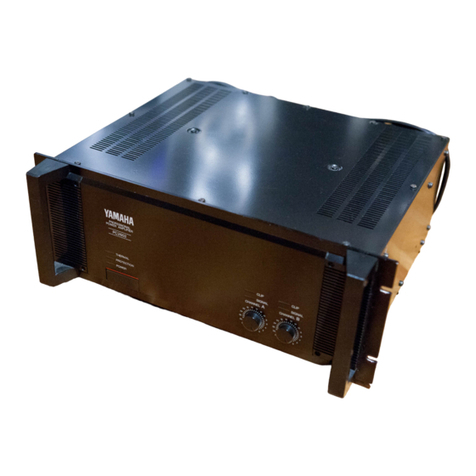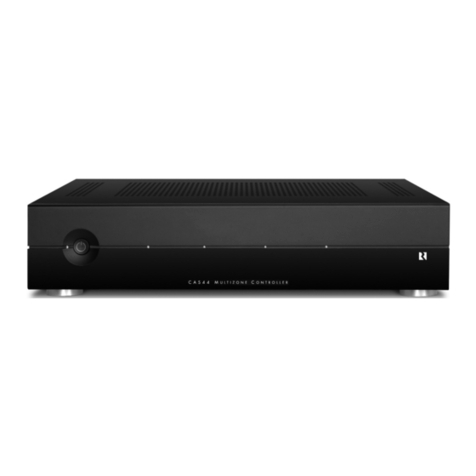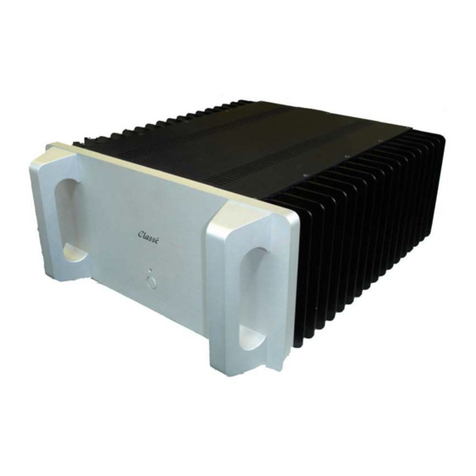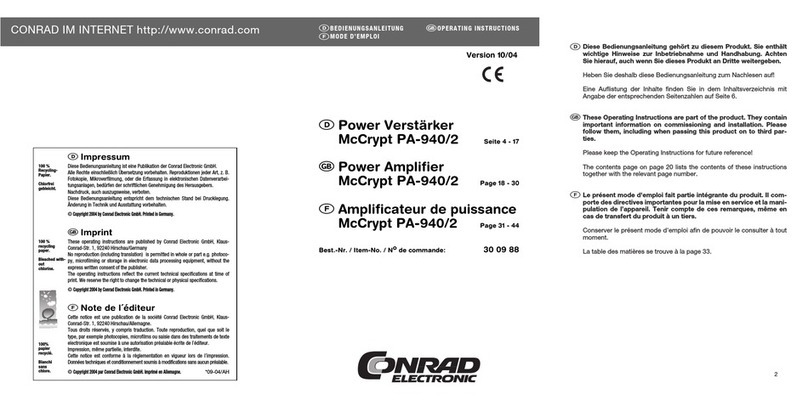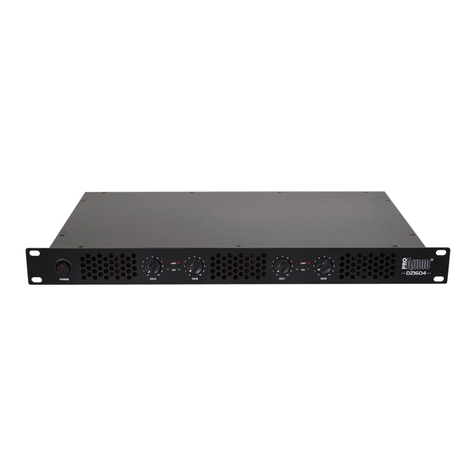Advanced Amplifiers AA-28G-2KW-PT User manual

User Manual
AA-28G-2KW-PT
R.F. MICROWAVE AMPLIFIER SYSTEM
Advanced Test Equipment Corporation
10401 Roselle Street
San Diego, CA 92121
Telep one: 808-404-2832

Table of Contents
Purpose of t e Equipment..........................................................................................................................3
General System Introduction.....................................................................................................................4
Installation........................................................................................................................................4
TWTA connections...........................................................................................................................4
Front Panel Display....................................................................................................................................6
Operation....................................................................................................................................................9
Remote Operation....................................................................................................................................12
Explanations of analog values.............................................................................................................12
Explanation of Faults and Flags..........................................................................................................13
Page 2 of 13

Purpose of the Equipment
T e TWTA is designed to amplify RF signals to ig power levels. It consists of a TWT and ot er RF
components, solid state electronic power supplies, control logic, built-in fault and status monitors so as
to provide safety to t e operator, t e electronics, and t e TWT.
WARNING!
•Do Not operate t is equipment wit t e covers removed.
•Do Not ave t e equipment plugged into AC Power wit t e covers removed.
•Do Not remove t e covers wit out waiting 5 minutes after t e unit as been unplugged from
AC power
•Do Not operate t is equipment wit out bot RF input and RF output being properly terminated.
•Do Not bypass or attempt to modify t e operation of t e Safety Interlock Switc .
•Wit out covers in place, personnel can be subjected to dangerous Hig Voltages w ic can
cause serious injury or deat . Wit out t e covers in place t ere will be inadequate cooling to t e
internal components resulting in serious damage.
•Wit out t e RF input and RF output being properly terminated, serious injury to personnel can
occur.
•Wit out t e RF input and RF output being properly terminated, serious damage to t e internal
components can occur.
CAUTION
Read t e preceding paragrap s before operating t e power supplies.
Page 3 of 13

General System Introduction
Prime power is connected to t e TWTA unit via t e t ree prong socket in t e rear of t e enclosure. It is
fused and controlled by t e Main Relay.
T e Front Panel Switc es control t e TWTA. T e WARM UP button controls t e Main Relay to power
t e unit. T e STANDBY, OPERATE and RESET buttons control various stages of t e unit operation.
T e Front Panel Display s ows current status of t e unit and allows to c ange certain parameters.
T e computer interface, specified at time of manufacture, allows t e user to emulate t e STANDBY,
OPERATE and RESET buttons remotely as well as read status of t e unit and c ange amplifier’s
settings and parameters. It also allows to set t e internal video pulse generator.
T e Low Voltage Power Supply provides regulated and filtered low voltages to various components
wit in t e TWTA. It also contains a microprocessor to monitor cooling fan currents.
T e TWT is connected to t e external termination points wit various RF configurations specified at
time of manufacture.
Installation
Locate amplifier in suc a manner t at adequate cool air is available to t e fan inlet on t e front of t e
unit. Do not restrict space in t e back of t e unit suc t at ex aust air is confined or blocked.
Properly terminate bot RF input and RF output wit appropriate RF components and at appropriate
drive and frequency levels.
Connect AC power to appropriate voltage and frequencies only, wit 15 amp service minimum and
adequate gauged wiring (12AWG recommended).
Safety ground in connecter must be used, and, for 120vac applications, Line and Neutral must not be
reversed. If reversed, t e unit will not function.
TWTA connections
•Output sample –40 dB - Provides a sample of t e output power at a 40 dB reduction for power
monitoring and spectral analysis.
•Input sample –20 dB - Provides a sample of t e input power at a 20 dB reduction for power
monitoring and spectral analysis.
•Interstage sample –20 dB - A sample of t e RF stream between t e Solid State Amplifier and
t e TWT at a 20 dB reduction. Provides a means of TWT gain calibration.
•Detected video output - A crystal-detected representation of t e RF output power.
Page 4 of 13

•Video pulses - Pulsed application only. Input for user-supplied video pulses.
•RF input - TWT Input for user-supplied RF.
•RF output - Amplified TWT RF output.
•Computer interface - Connection for user-specified external communications.
•Primary power - User-specified 120 or 240VAC 50-60 Hz power input.
Picture 1: Front view
Picture 2: Back view
Page 5 of 13

ront Panel Display
Front panel display interface consists of 8 screens, Home, Fault Count, Floating Deck, Hig Voltage,
Elapsed Time Meters, Temperature, Input Pulses and Settings. A panel of 8 buttons on t e left side
allows to switc between screens. T ere is also a status area in t e lower rig t corner w ic constantly
s ows t e current state of t e unit.
T ere are 4 main states of operation of t e amplifier. In WARM UP, t e unit is waiting until t e tube
eater ac ieves t e correct temperature and all t e currents and voltages stabilize. In t is state t e status
bar s ows ow muc time is left to finis t e warm up. After t e warm up time finis es t e unit enters
STANDBY. In STANDBY and OPERATE t e status area s ows ambient temperature inside t e unit.
Finally, in t e case of RESET, t e status area s ows ow many faults were present at t e time RESET
state was triggered.
Picture 3: Home screen, Standby
Picture 4: Home Screen, Reset
Home Screen (picture 3) is t e screen s own by default after t e unit turns on.
Picture 5: F oating Deck Screen
Picture 6: High Vo tage Screen
Floating Deck and Hig Voltage screens (picture 5 and 6) present readings of t e monitored
parameters. T e values are updated in real time.
Page 6 of 13

Picture 7: Fau t Count Screen
Fault Log screen (picture 7), s ows t e count of faults w ic ave occurred since t e last time t e fault
log was cleared. Some faults correspond to analog values s own on ot er screens, some correspond to
interlock switc es connected to various components of t e amplifier and ot er ardware and software
errors. See appendix and appendix for detailed explanations.
Picture 8: E apsed Time Meters Screen
Picture 9: Temperature Screen
Elapsed Time Meters screen (Picture 8) s ows t e following information:
•Total time unit on – Total Time t e unit as been in powered on.
•Total time in operate – Total Time t e unit as been in OPERATE ( ig voltages on).
•Total time main uptime – T e main control board is powered w enever t e prime power input is
connected to AC power. T is timer measures total time t e main control board was powered.
•Main boot up count – T is counter is incremented eac time t e main control board is powered
on, meaning essentially eac time t e prime power input is connected to AC power.
•Power up count – T is counter is incremented eac time t e unit goes from POWER OFF to
STANDBY.
•Operate count – T is counter is incremented eac time t e unit turns on ig voltages (even, if
t ere is a fault and it goes to reset immediately).
•Power on time – Time since last power on.
Page 7 of 13

•Operate time – Time since last time t e ig voltages were turned on. If in state ot er t an
OPERATE it s ows t e duration t e unit was in OPERATE last time.
•Main uptime – Time since last time t e main control board was powered, meaning essentially
t e last time t e prime power input was connected to AC power.
Temperature screen (Picture 9) s ows t e temperature of t e main control processor, w ic in general
represents t e ambient air temperature inside t e unit.
Picture 10: Pu ses screen
T e Pulses screen (Picture 10) s ows measurements of t e incoming “video” pulses. PpinP stands for
Pulse in Period, PinL for Pulse in Lengt and PinD for Pulse in Duty [cycle]. W en t e pulse input is
set to CW, PinP and PinL is undefined w ile PinD s ows 100 %. T e values s own correspond to
pulses w ic will modulate t e amplifier’s output, w en t e amplifier is in OPERATE. So t e values
represent t e output of t e internal pulse generator, w en it is activated, and video pulse input, w en it
is deactivated.
Picture 11: Options screen, System tab Picture 12: Contact screen
Options screen consists of 4 tabs. Contact tab (picture 12) s ows t e contact information of t e
amplifier’s manufacturer. System tab (picture 11) s ows general information about t e amplifier and
selected tec nical data.
T e following information is available: Model, Series, Rated power output, Min. and max. supported
frequency and serial number, ADC sampling rate for main control and RF control.
Page 8 of 13

Operation
Terminate TWTA RF input and output. Connect external Interface as desired. Apply prime power.
Caution: The TWTA must never be placed in Operate without proper RF termination. This can lead
to TWT oscillations which can permanently damage the TWT.
Power TWTA On:
Press t e manual WARM UP button to power t e TWTA. T e manual WARM UP button will
illuminate. Front panel display will s ow “Warm up” and t e remaining warm-up time in t e status
area.
At initial power-up, eater voltage will be less t an nominal to limit excessive current drawn by a cold
filament. As t e filament warms it will draw less current and t e filament voltage will increase until
nominal voltage is reac ed. Negative Bias voltage is applied to t e Grid. Body and Collector supplies
are off. T e standard warm-up period is 5 minutes.
Standby from Warm-up:
After t e warm-up period as elapsed t e TWTA is placed in STANDBY by t e main microprocessor.
Hig voltage supplies and Grid voltage remain unc anged from t e WARM UP state. T e manual
STANDBY button is illuminated and t e WARM UP/OFF button is extinguis ed. T e front panel
display will indicate “Standby” on t e status area. T e TWTA can be now placed in OPERATE.
Operate:
Press t e OPERATE button to place t e TWTA in OPERATE state or send t e OPERATE command
from t e remote computer. T e OPERATE button is illuminated and t e STANDBY button is
extinguis ed. T e front panel display will indicate “Operate” on t e status bar and t e background
color will c ange to green.
T e Main microprocessor engages t e Collector voltage soon after t e OPERATE command is received
and t e Body voltage 500 ms after t e Collector voltage stabilizes. T en it waits up to 3 seconds for t e
Collector voltage to stabilize before going to OPERATE. Bot STANDBY and OPERATE buttons are
illuminated during t e Hig Voltage on sequence. T e amplifier goes to RESET if t e voltages don’t
reac t e nominal values wit in allowed time. 8 s after t e ig voltages ave reac ed t eir nominal
values, pulses are passed unaltered to t e Floating Deck w ere t ey are subject to PRF (Pulse
Frequency) and PW (Pulse Widt ) limiting. T e TWT beam current will be present wit in up to 13.5 s
after t e TWTA OPERATE command is sent.
If RF and video pulses (pulsed units) are supplied, t e TWTA will produce an amplified RF output.
Standby from Operate:
W en placed in STANDBY by user command, t e main processor sequentially interrupts video pulses
to t e Floating Deck, disengages t e Body and Collector supplies and returns t e TWTA to STANDBY.
Page 9 of 13

T e STANDBY button illuminates and t e OPERATE button is extinguis ed. Front panel display
s ows “Standby” on t e status bar again.
Power TWTA Off:
After placing t e TWTA in STANDBY press WARM UP button to power-down t e TWTA.
If t e TWTA was operating at ig -duty t e amplifier s ould be run in STANDBY an additional lengt
of time to allow t e TWT to cool.
Reset:
If any monitored parameter falls outside t e limits set in t e processors, t e Main processor interrupts
pulses and disengages t e ig voltage supplies in a fas ion similar to STANDBY but latc es t e
system in RESET. T e RESET button is illuminated and t e front panel display status area s ows t e
word “Reset” and t e Home screen lists t e faults w ic triggered t e RESET, toget er wit values
latc ed at t e moment t e fault occured.
After t e cause of t e fault as been corrected press t e RESET button to return t e TWTA to
STANDBY.
TWT Temperature, cooling fans, cover Interlock, VSWR and Helix Current are all directly monitored
by t e Main Control and will cause t e Main Control processor to place t e TWTA in RESET if t e
amplifier is in WARMUP, STANDBY or OPERATE.
Heater Voltage and Current, Drive Voltage, Collector Voltage and Current, Body Voltage and Cat ode
Current are all directly monitored by t e RF Control. Collector Voltage and Body Voltage will not
trigger a fault until t e TWTA is in operate. Heater Current and Heater Voltage will not trigger a fault
during a specified time after t e unit was turned on.
Grid Voltage and t e RF Control Board +9V supply are andled uniquely; t ey are monitored by t e
RF Control processor but will initiate a Flas ing Reset.
Flas ing Reset:
FLASHING RESET indicates a fault w ic needs t e Main Control board to turn t e unit off to prevent
serious damage.
T e following events will trigger t e Flas ing Reset.
Grid voltage out of range or t e RF Control Board +9V supply too ig . Hig +9V supply or ig grid
voltage (absolute value) will cause a FLASHING RESET at any time w ile low grid voltage will cause
a FLASHING RESET only in WARM UP or STANDBY. Low grid voltage in OPERATE will not cause
a fault.
W en t ere is an unexpected be avior of Main Control Board or RF Control Board firmware w ic
trigger a watc dog to reset t e microcontroller. After suc a reset, t e unit will immediately go to
FLASHING RESET.
Page 10 of 13

W en t e Main Control looses communication wit RF Control or w en it is not able to detect it after
being turned on.
W en t ere is a uncorrectable error w en reading microcontroller flas memory from a critical region.
W en t e TWTA is in t is mode all t e components, except t e Main Control Board are disabled, to
protect from damage. Front panel display will be switc ed off and t e external communication port
mig t be disabled (depends on t e type of t e communication port). To clear a Flas ing Reset t e
TWTA must be power-cycled. If t e condition t at caused t e FLASHING RESET remains, t e
amplifier will enter t e FLASHING RESET mode again.
Gassy TWT:
If t e TWTA as been inactive for several mont s t e TWT may build up gasses. T is allows t e TWT
to arc internally and cause repeated TWTA faults.
To correct t is condition, operate t e TWTA for an extended period wit no input pulses. W en a fault
occurs, reset t e TWTA and return to operate. A TWT t at is recovering will be evidenced by a
widening period between faults. T e lengt of time required will be determined by t e particular TWT,
possibly up to twenty-four ours.
T e TWTA s ould be operated periodically to prevent gassing.
Internal Pulse Generator:
T e Internal Pulse Generator can be controlled remotely (Refer to t e “10000 Series Communication
Protocol” document for more details) and from t e Front Panel Display (see page 8).
Page 11 of 13

Remote Operation
Please refer to t e document “10000 Series Communication Protocol” for details regarding command
encoding, status and analog readings data format as well as command syntax description.
Explanations of analog values
•VSWR - For pulsed amplifiers, VSWR will display eit er a value close to 0, if t e reflected
power is wit in acceptable levels, or a value above 8000, if t e reflected power is excessive. In
t e former case, t e TWTA will fault.
•Heater I, Heater V - TWT filament current and voltage. T e faults are ignored during WARM
UP.
•Grid V - Indicates t e voltage at t e TWT grid. W en t e TWTA is in Warmup or Standby t e
grid voltage will be virtually identical to bias voltage, reflecting t e bias voltage t at is applied
to t e grid. T e operator s ould not misinterpret t e Grid display as a direct representation of
bias voltage.
W en in Operate wit pulses applied t e Grid will display a lower (absolute) value due to t e
positive drive pulses interspersed wit t e negative bias voltage. T e amount of reduction is
directly proportional to t e duty cycle of t e pulses applied.
•Bias V - Direct measurement of Bias Voltage. Not present in all units (depends on RFC
version).
•Drive V - Monitors positive drive voltage wit maximum and minimum limits. TWTA will not
fault until placed in Operate.
•Co ector V - Indicates collector voltage. Collector voltage is present only w en t e TWTA is
in Operate.
•Co ector I - Indicates collector current wit maximum limits only. Collector current is present
only w en t e TWTA is in Operate wit pulses applied (pulsed TWTA’s). CW TWTAs will
produce Collector current w enever t e TWTA is in operate.
•Body V - Indicates body voltage wit maximum and minimum limits. Body voltage is present
only w en t e TWTA is in Operate. Also known as Cat ode or Helix voltage.
•Cathode I - Indicates cat ode current wit maximum limits only. Cat ode current is present
only w en t e TWTA is in Operate and CW or pulses are applied (pulsed TWTA’s).
•He ix I - Helix current is present only w en t e TWTA is in Operate and CW or pulses are
applied (pulsed TWTA’s).
Page 12 of 13

Explanation of aults and lags
•Temperature & Fan - TWT temperature as exceeded acceptable levels or a cooling fan is
outside its current range. Causes a fault.
•Inter ock - T e enclosure cover as been removed or loosened. Causes a fault.
Page 13 of 13
Table of contents
Other Advanced Amplifiers Amplifier manuals
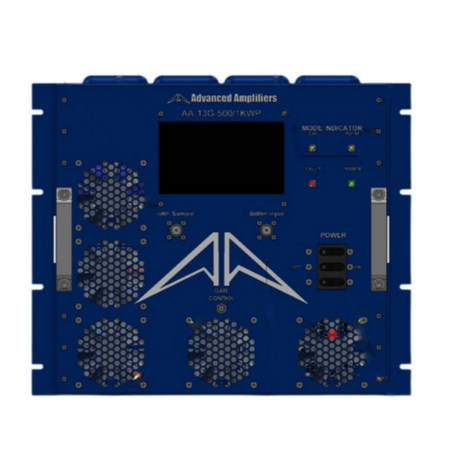
Advanced Amplifiers
Advanced Amplifiers AMP2103P-LC User manual
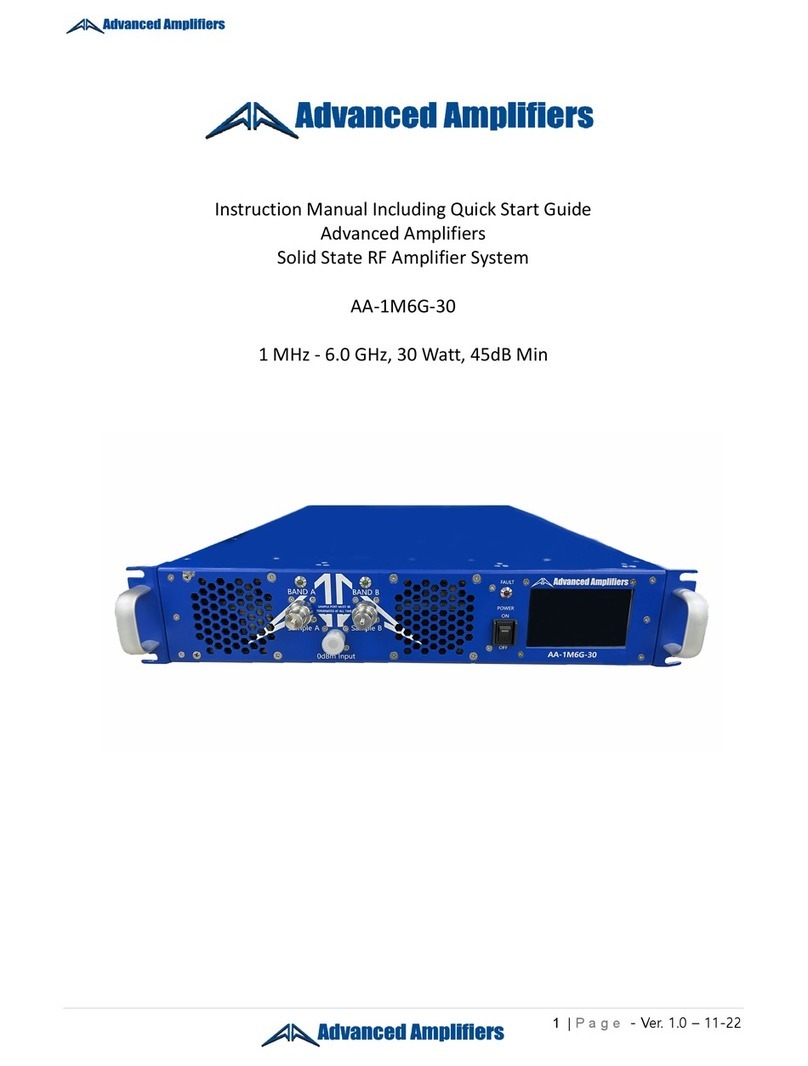
Advanced Amplifiers
Advanced Amplifiers AA-1M6G-30 User manual

Advanced Amplifiers
Advanced Amplifiers AA-1218G-3.5KW-PT User manual
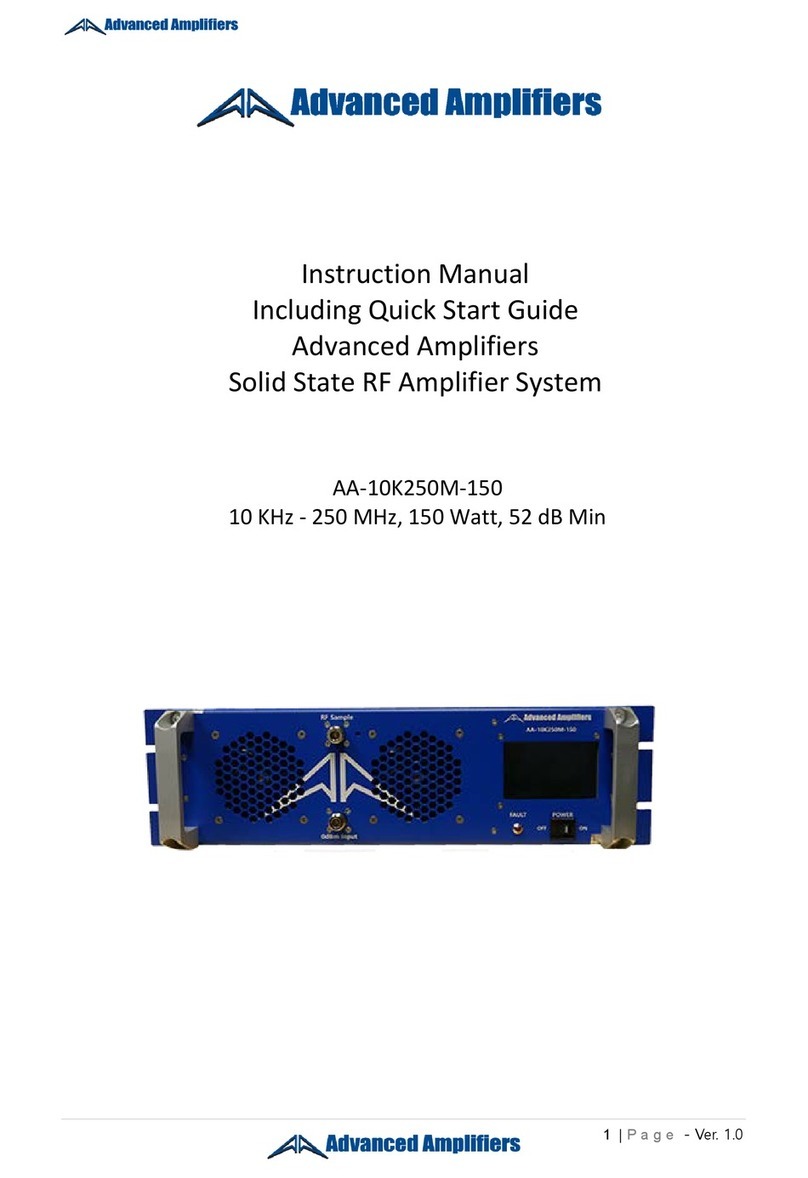
Advanced Amplifiers
Advanced Amplifiers AA-10K250M-150 User manual

Advanced Amplifiers
Advanced Amplifiers AA-20M1G-50 User manual
